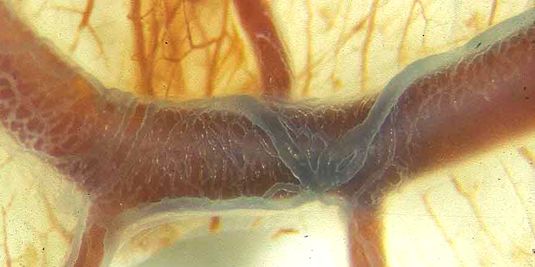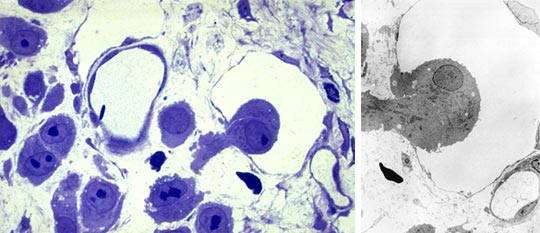Research
All higher vertebrates including man develop two vascular systems, which are essential for the regulation of homeostasis: the blood vascular system and the lymphatics (Fig. 1). Diseases of the blood vascular system are the major cause for deaths in industrialized countries. Diseases of the lymphatic vascular system cause lymphedema, which has to be treated life-long. Both vascular systems develop not only within the embryo but also in tumors, and are of great relevance for the hematogenic and lymphogenic spread of tumor cells. The two vascular systems possess structural and molecular similarities, but they also differ in many details. They are lined by endothelial cell, which differ in approximately 2 % of the expressed genes. The transcription factors SOX 18 und PROX 1 are essential for the development of lymphatic endothelial cells (LECs). Without the activity of Vascular Endothelial Growth Factor-A (VEGF-A) and its receptor (VEGFR-2/KDR) endothelial cells do not develop. Antibodies against VEGF-A have been approved for the antiangiogenesis therapy of colon cancer. The related protein VEGF-C induces the development of lymphatics.

Fig. 1: Lymphatics (blue) in the adventitia of a vein. Lymphatic capillaries drain fluid into larger precollectors and collectors
For the development of new therapeutic strategies it is important to study the cellular and molecular mechanisms of blood vessel development (hemangiogenesis) and lymphatic vessel development (lymphangiogenesis). Characterization of precursor cells of the endothelium is of great importance for regenerative medicine. Precursor cells may be useful for the treatment of lymphovascular hypoplasia (Nonne-Milroy Syndrome), whereas inhibitors can be useful to treat hyperplasias (hemangioma, lymphangioma).
80% of carcinomas metastasize via the lymphatic vascular system, and the lymph node status is of utmost significance for therapy (Fig. 2). Since the discovery of the effects of VEGF-C on lymphangiogenesis and lymphogenic metastasis, several researchers try to characterize new mechanisms that support these processes. We are studying an infantile tumor, neuroblastoma(NB), which metastasizes via blood vessels into bone barrow, and via lymphatics into distant lymph nodes. NB is derived from sympatho-adrenal neural crest cells, and is mostly located along the sympathetic chain ganglia and in the adrenal medulla. Migration and differentiation of neural crest cells is controlled by growth and guidance factors. Such factors may also be expressed by endothelial cells, and it is very likely that they also control the migration of tumor cells.
Our department studies the cellular and molecular mechanisms of hem- and lymphangiogenesis, and the hematogenic and lymphogenic spread of tumor cells.

Fig. 2: Immigration of two melanocytes into a lymphatic capillary. Left: Semi-thin section. Right: The same cells are shown by transmission electron microscopy


